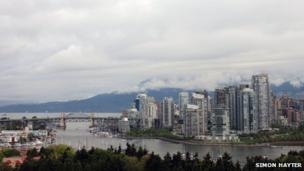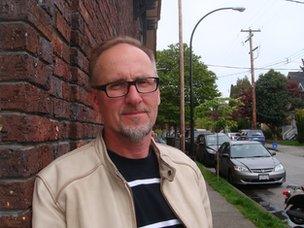Canada prepares for an Asian future
- 25 May 2012
- World Radio and TV

Chinese immigrants have flocked to Canada's west coast and transformed Vancouver into Canada's very own Asian metropolis. The days of concern over the city being turned into 'Hongcouver' have gone. What does the future hold for Canada's Asian population?
Shoppers stroll casually past a Lamborghini store in Richmond's Aberdeen Centre - a major Asian mall in this once sleepy Vancouver suburb known for its farmland and fishing village.
Outside the shopping centre, people are queuing at the many Chinese restaurants. In the local supermarkets, butchers are picking live seafood out of fish tanks, chopping off the heads, then gutting and packaging them up under the watchful eye of customers, almost exclusively Chinese-Canadian.
Richmond is North America's most Asian city - 50% of residents here identify themselves as Chinese. But it's not just here that the Chinese community in British Columbia (BC) - some 407,000 strong - has left its mark. All across Vancouver, Chinese-Canadians have helped shape the local landscape.
Increasing trade
There are the little things. Casa Gelato - an Italian ice-cream shop with a huge local following - sells Asian-inspired flavours such as green tea, durian and lychee. The Vancouver Sun newspaper puts out an online Mandarin edition, Taiyangbao. The province's auto insurance corporation serves drivers in 170 languages - Mandarin and Cantonese being the most in-demand.
Then there are the big contributions.
"Economic growth is obvious and easy to measure," says Thomas Tam, the CEO of Success, an immigrant service based in Vancouver's historic Chinatown.
For the first time in 2011, the Pacific Rim dislodged the US as British Columbia's biggest trade partner . With the collapse of the US housing market, lumber exports have fallen. But demand for coal and natural gas to fuel China's factories is skyrocketing.
Exports to China reached CAN$5.1bn ($5bn/£3.17bn) in 2011, nearly five times their value in 2001. Other booming industries include agrifoods, minerals, container traffic, tourism and education. The economic boost has driven a CAN$22bn ($21.6bn/£13.7bn) upgrade in infrastructure along trade corridors with Asia.
"Within the last 20 years, we have expanded our airport twice, had a big facelift for our port, and seen the biggest-ever highway construction," he says. "Because of the impact of immigration, Canada as a whole is more resilient to economic recession and that's undeniable."
For centuries, Chinese immigrants have come to Canada for economic opportunities. It began with the gold rush in northern and central BC in 1858. In the 1880s, some 6,500 Chinese migrants were directly employed by the Canadian Pacific Railway (CPR), settling in towns along the railway route, all the way to the terminus in Vancouver, where the fledgling Chinatown took root (now the third-largest in North America).
But resentment grew among the white working classes, who saw the migrants as cheap labour, the so-called "yellow peril" stealing jobs and sullying society. In 1885, the federal government enacted the first anti-Chinese legislation, imposing a ' head tax ' of CAN$50 on every migrant worker.
Under the Chinese Exclusion Act of 1923, immigration ground to a halt. The ban was lifted in 1947 - due in part to the contribution of Chinese-Canadian soldiers in WWII - but Mao's red revolution closed the door at the other end.
Sharp backlash
The next significant wave of migrants came in the 1980s and 90s. But they weren't about to do manual labour or settle in Chinatown with the so-called Chi-eppies (Chinese elderly people) and Chi-lippies (Chinese low-income people).
This was a largely wealthy class of Hong Kong Chinese who snapped up homes in the priciest neighbourhoods, sent their children to the best schools, and kicked off a construction boom which transformed downtown Vancouver into a Hong Kong-style city of skyscrapers.

Their sudden impact brought a sharp backlash. Polite Vancouver society was aghast at the "monster houses" being built in the old-monied communities of Shaughnessy and Kerrisdale, often demolishing character homes and tearing down trees in the process.
Newspaper headlines and some politicians warned of an "Asian invasion" while the bitter elite coined the phrase 'Hongcouver' to express their dismay at the perceived Asian-isation of their city.
"The wealth of the newcomers was an irritation to some in the local community," says historian John Douglas Belshaw, a professor at the University of Victoria. But attitudes soon began to change, he says.
"The elite says, 'Our bread's buttered on this side. We can sell a ton of real estate to this community and they're kind of like us. These people like their whiskey straight'."
Mandarin increase
The Hong Kong wave subsided after the British handover to China in 1997. Since then, immigrants from Mainland China, and to a lesser extent, Taiwan are leading the westward charge.
Mandarin is edging out Cantonese on the streets of the city. Overall, nearly one-in-five Vancouverites is now of Chinese origin - the biggest migrant community by far, with some 12,400 new arrivals each year.
Privately, there have been grumblings. In the safety of living rooms or the anonymity of online forums, old-time Vancouverites blame the Chinese for the city's sky-high property prices, although experts say there's little evidence to back up the fears.
Language is another flashpoint, especially when it comes to older migrants. "There used to be a time when immigrants to this country were required to know the language," whispers a woman in a doctor's clinic, as the receptionist struggles to ask an elderly Chinese man when he last took his heart medication. A family member has to be contacted by phone before the queue gets moving again.

There's concern too that foreign students are taking up places at university, bringing much-needed bags of cash in foreign student fees. A similar problem is playing out in schools, some say.
"My son wants out of private school," says one parent who asked not to be named. His teenager has become one of the few white students at an exclusive Christian academy in a Vancouver suburb. "All these Asian kids are playing the piano and violin in the evenings. My kid plays hockey," he says.
It's not uncommon to find only one or two white students in Vancouver classrooms, says Mr Tam in his Chinatown office, especially in courses like finance or engineering.
He says he gives the same advice to all young people - Asian and non-Asian - struggling to find their place: "Take this as an opportunity rather than a challenge.
"The future is in Asia and Vancouver has a very good advantage, which is that of all the Canadian cities, we are the closest to the Asia Pacific Rim."
That reality is reflected in the BC government's economic plan, aptly titled " Canada starts here " - a clear reference to BC as the Pacific gateway, a full three sailing days closer than anywhere else in North America.
"Our government is focused on making sure British Columbians are first in line to do business with Asia to create jobs here at home," says Premier Christy Clark.
"Vancouver and British Columbia are a natural place for many Asian families because of our diversity. There are countless personal and cultural connections here and our economy and province is richer, more vibrant and attractive for newcomers as a result," her office said in a statement.
No comments:
Post a Comment
Comments always welcome!